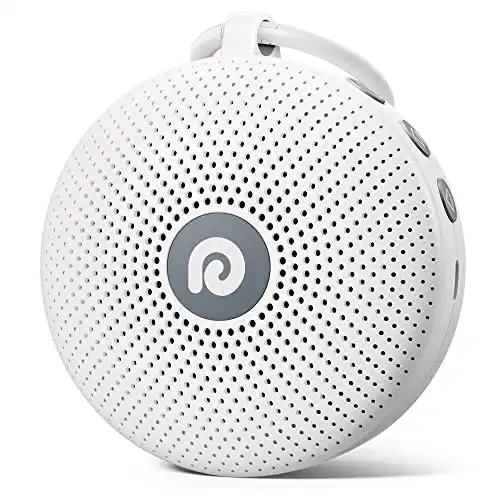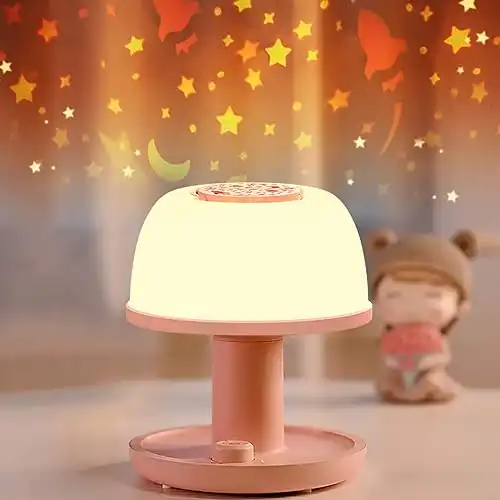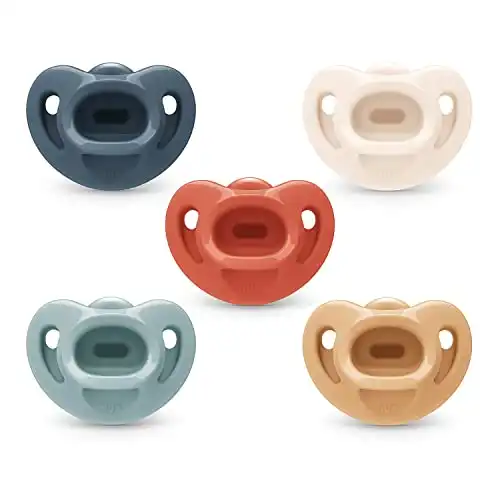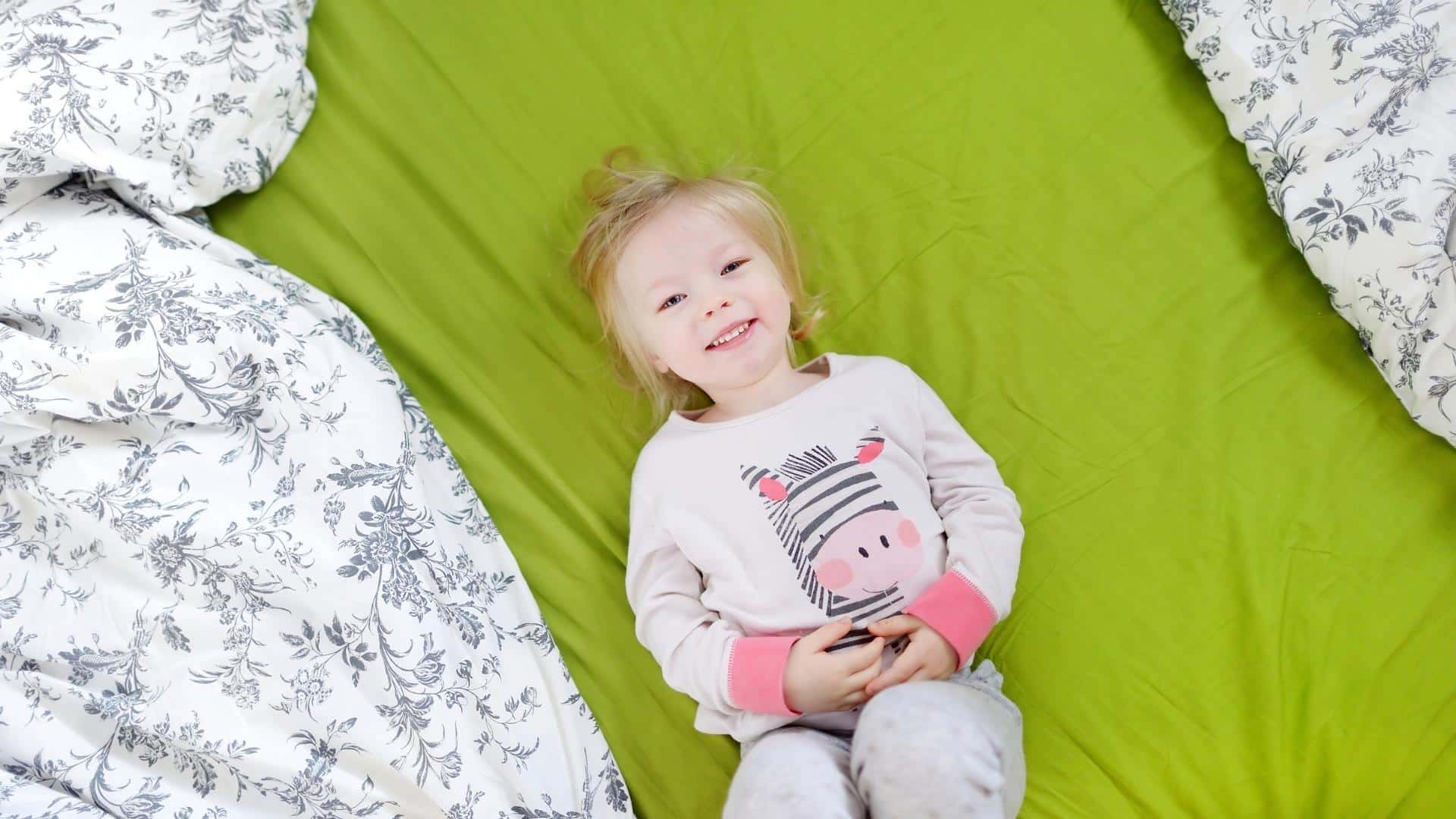As a parent, you want your baby to feel comfortable and at ease. One way to achieve this is by understanding how to self soothe baby. For calm naps, seamless nighttime sleep and independent children, this vital skill cannot be underestimated.
What Is Self-Soothing?
Self-soothing is the ability of a baby to calm themselves down without the need for external help or intervention. When a baby learns to self-soothe, they can calm down and relax on their own, which helps them to cope with stress and anxiety. It is without doubt one of the most important coping skills that babies need to learn, and it helps them to develop self-control and emotional regulation.
Why Is Self-Soothing Important?
As already mentioned self-soothing is an important life skill for babies to learn as it helps them manage their emotions and cope with stress and anxiety.
When a baby is able to self-soothe, they can also move onto self-settling by falling asleep or returning to sleep on their own, without needing assistance from their caregiver. This can lead to better sleep for both your baby and you.
Self-soothing can also help with separation anxiety, which is common in babies and young children.
When a baby can self-soothe, they may feel more secure and less anxious when separated from you or their caregiver.
Learning to self-soothe can also have long-term benefits for a child’s mental health and overall health. Babies who are able to self-soothe may develop better coping skills and self-control as they grow older.
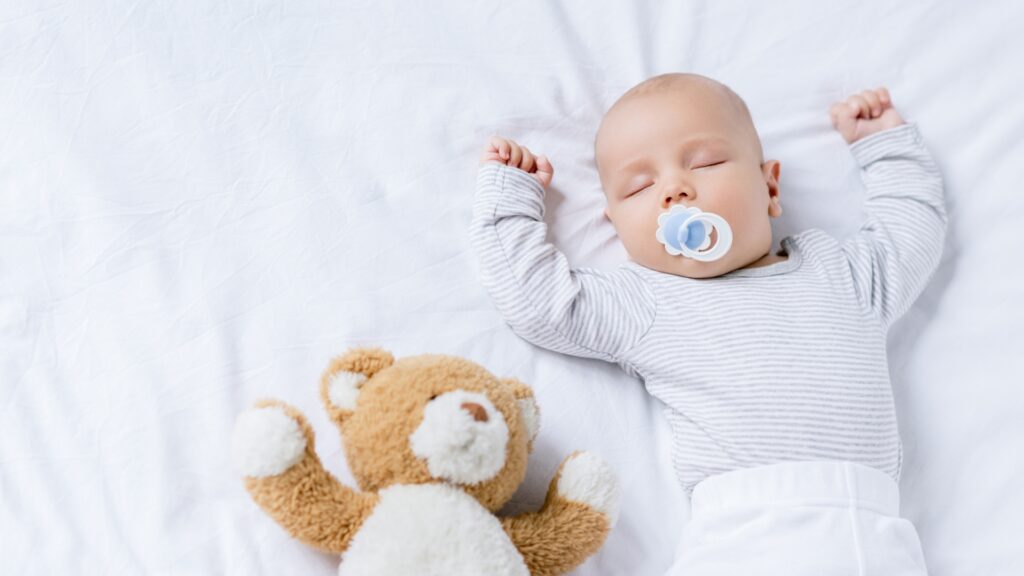
What Age Should A Baby Self-Soothe?
There is no set age at which all babies will be able to self-soothe. However, there are some general guidelines to keep in mind.
Newborns typically rely on their parents and caregivers to help them fall asleep and stay asleep. They regularly need to be fed, rocked, or held to feel secure enough to sleep.
However, as babies grow and develop, at around 3-4 months of age some may start to show signs of naturally self-soothing.
By 6 months of age, most babies are capable of self-soothing after nighttime feeds and before daytime naps.
Signs Baby Can Self-Soothe
Some signs that your baby may be ready to start self-soothing include:
- Longer stretches of sleep at night
- Fewer night wakings
- Calming down more quickly when upset
- Sucking on their fingers or a pacifier
- Turning their head away from stimulation when tired
REMEMBER: Every baby develops at their own pace, so don’t worry if your baby is not self-soothing by a certain age. With patience and consistency, your baby will learn to self-soothe in their own time.
How To Teach Baby To Self-Soothe
Teaching your baby to self-soothe is a process that requires patience and persistence. It is an important step towards promoting independence and helping your baby learn to soothe themselves when they are upset or tired.
Here are some tips to help you teach your baby to self-soothe.
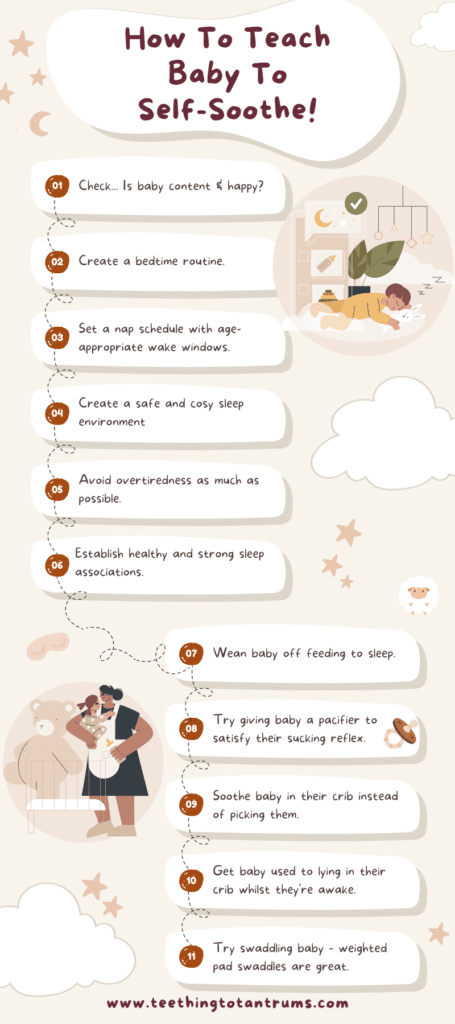
1. Check… Is Your Baby Content?
Before you start teaching your baby to self-soothe, make sure that their basic needs are met. Check if your baby is hungry, wet, or needs a diaper change. Ensure that they are comfortable and not too hot or cold. Once you have addressed their needs, you can start teaching them to self-soothe.
2. Create A Bedtime Routine
Establishing a consistent bedtime routine can help your baby learn to self-soothe. A regular bedtime helps your baby’s body get into a sleep pattern and sleep cycle.
You can start the sleep routine by taking a warm bath, singing a lullaby, or reading a story. This will help your baby understand when sleep time is approaching.
3. Set An Appropriate Nap Schedule
Having a regular age-appropriate nap schedule can also help your baby learn to self-soothe. An appropriate nap schedule can help your baby get enough rest and avoid getting overstimulated or overtired both of which will prevent your little one from being able to self settle successfully.
Ensure that your baby has a comfortable and quiet sleep environment during daytime naps.
4. Create A Safe And Cosy Sleep Environment
Creating a safe and cosy sleep environment will help your baby learn to self-soothe. Ensure that your baby’s crib is safe and cosy with a firm mattress and fitted sheet. Using a white noise machine can also help your baby sleep to settle.
White noise machines are a game-changer for your little one's sleep and having one that plays all night is a must. With a long-lasting battery, this compact and stylish white noise machine contains 21 non-stop relaxing noises, which will lull your little one to sleep night after night, no matter where you are!
5. Avoid Overtiredness
Avoiding overtiredness is at the top of my list of ways to help your baby learn to self-soothe.
An overtired baby will struggle to self soothe due to the fact their body is producing cortisol and adrenaline to compensate for being overtired. This can result in them having a hard time calming down sufficiently enough to fall asleep and stay asleep.
Therefore, try to ensure that they’re well-rested and calm before you put baby to bed.
6. Establish Healthy Sleep Associations
Establishing healthy sleep associations can help your baby learn to self-soothe. You can create a sleep routine that includes soothing activities like a warm bath, massage, reading a story or singing a lullaby.
You can also use a night light to create a cosy environment that reduces the need to turn on a main light during night feeds. All of these repeating actions and events will help your baby associate with being calm and sleepy.
Finding the right night light for your child can be quite a task. You want something safe, comforting, and practical. The Cozy Starry Night Light ticks these boxes, with eye-friendly warm lighting and an easy-to-use dimmer.
Its gentle glow makes it the best night light for feeding baby, diaper changes, or comforting your little one back to sleep.
As your baby grows the Cozy Starry Night Light's starry sky projection can provide comfort and gentle quiet time stimulation. Its soft lighting ensures a dreamy, peaceful environment, supporting your baby’s natural sleep cycle.
It really is a fantastic nightlight (at a very reasonable price!)
- Eye-friendly warm lighting with adjustable brightness.
- Includes a timer function for convenience.
- Projects a starry sky that is soothing for little ones.
- Rechargeable battery, so it's very portable.
- A USB adapter is not included for charging.
- The star projector is static without motion (however, this is ideal for very young babies and toddlers).
- Battery life varies based on the brightness settings.
7. Wean Off Feeding Baby To Sleep
It is very common for new babies to feed to sleep and that is OK. However, this is a habit that you ideally need to break as your baby grows.
Weaning off feeding to sleep will help your baby learn to self-soothe. If your baby is used to nursing or taking a bottle to fall asleep or calm down, try to gradually reduce the amount of time spent feeding before sleep and put your little one down before they are fast asleep.
This will help your baby learn to self soothe and fall asleep without relying on feeding.
8. Try Giving Baby A Pacifier
Whilst this won’t work for every baby, a pacifier can be very comforting for a lot of babies which can help them to soothe themselves.
They are especially useful if you are weaning off feeding baby to sleep as the sucking reflex is swapped from your breast or bottle for the pacifier.
A pacifier might help your baby sleep through the night and could also help prevent sudden infant death syndrome (SIDS).
These cute dishwasher-safe orthodontic pacifiers have a teat that is designed to allow for a natural sucking motion, reducing pressure on the jaw and teeth, and preventing teeth misalignment! Their heart-shaped shield also fits perfectly under baby’s nose for easy breathing making them the perfect pacifier for your baby!
NOTE: When baby is young, you will need to replace their pacifier when it falls out as they will not yet be able to do this for themselves yet.
9. Soothe Baby In Crib Instead Of Picking Them Up
When your baby is upset or crying, try to soothe them in their crib instead of picking them up. You can pat their back or rub their tummy to help them calm down.
This will help your baby learn to self-soothe and fall asleep on their own and break the habit of them always expecting you to pick them up or rock them to calm them down.
10. Get Your Baby Used To Lying In Their Crib Whilst Awake
Another great way to help your baby to learn to self soothe is to get them used to being on their own when awake.
Put your baby in their crib for short periods of time (usually a couple of minutes) a couple of times a day whilst they are wide awake and let them look around or watch a mobile. This will allow them to become associated with their sleep space when not asleep and encourage them to self soothe.
11. Try Swaddling Baby
Swaddling your baby can help them learn to self soothe as they will feel safe and secure when wrapped in a swaddle and less likely to get anxious. It will also prevent them from startling themselves with the ‘Moro Reflex’ which can be quite alarming for some babies.
With soft, plush micro-fleece, this super soft swaddle wraps newborns in just the right amount of warmth. This sleep sack swaddle suits infants from birth to potentially 3 months, offering both comfort and safe sleep practices with its arm immobilization feature.
The innovative 3-way swaddling system adapts to a baby's sleep style, a crucial feature for those restless nights. Whether it's arms in, hands-to-face, or arms out, it grows with the baby's swaddling needs!
Meanwhile, the bottom zipper makes midnight diaper changes a breeze!
Looking to get your little one to sleep quickly and effortlessly through a healthy nighttime routine? Check out my Bedtime and Nap Cheat Sheet and master the art of making daytime naps and bedtimes as seamless as possible.
A bedtime & nap cheat sheet so good your little one will ask you to put them to bed...
Laura Williams "This is a life saver! I'm so glad I downloaded your bedtime & nap cheat sheet. My little one actually asked me to put him to bed last night! Unbelievable! Thank you so much!"
Click Here For The FREE Cheat Sheet
Pros And Cons Of Self-Soothing Babies
While it can be a lifesaver for sleep-deprived parents, there are both pros and cons to consider when it comes to self-soothing babies.
Pros Of Self Soothing
- Better sleep for baby: When a baby can self-soothe, they are less likely to wake up in the middle of the night and require a caregiver’s help to fall back asleep. This means they get more restful sleep, which is crucial for their growth and development.
- More independent: Self-soothing can help babies become more independent and confident in their ability to handle their emotions and needs on their own.
- Less stress for parents: When a baby can self-soothe, parents can get more sleep and have less stress, which can improve their overall well-being and ability to care for their child.
Cons Of Self Soothing
- Not all babies can do it: Not all babies are capable of self-soothing, and some may need more external soothing from caregivers to fall asleep and stay asleep.
- It can be difficult to teach: Teaching a baby to self-soothe can be a challenging process that requires patience and consistency.
- Crying can be stressful: Some parents find it difficult to listen to their baby cry, even if it is part of the self-soothing process. This can cause stress and anxiety for both the parent and the baby. I do not recommend letting babies cry it out in order to learn to self soothe. You should be able to teach your little one to fall asleep independently.
Overall, self-soothing can be a useful tool for both babies and parents, but it is important to consider each child’s individual needs and abilities before attempting to teach them how to self-soothe.
Falling asleep independently is not something you can force a baby to do and some will master the art better than others.
Just remember to be patient and help your baby achieve self soothing in a gentle and supportive manner.
Self-Soothing Baby Myths
As a new parent, you may have heard several myths about self-soothing babies. Here are some of the most common ones:
- Myth 1: Babies should self-soothe from birth. This is not true. Newborns need to be comforted and held often. They are not capable of self-soothing until they are a few months old.
- Myth 2: Self-soothing means leaving your baby to cry it out. This is a common misconception. Self-soothing means that your baby can calm themselves down and fall asleep without your help. It does not mean leaving your baby to cry for long periods.
- Myth 3: You should never help your baby fall asleep. This is not true. It’s okay to help your baby fall asleep when they are young. As they get older, you can gradually teach them to self-soothe.
- Myth 4: Self-soothing is a one-time event. Self-soothing is a skill that takes time to develop. It’s not something that happens overnight. Your baby may have good nights and bad nights when it comes to self-soothing.
- Myth 5: Self-soothing works for every baby. Every baby is different. Some babies may learn to self-soothe quickly, while others may take longer. It’s important to be patient and consistent when teaching your baby to self-soothe.
Frequently Asked Questions About How To Self Soothe Baby
Looking for more information about how to help baby learn to self-soothe? Here are the answers to the most common questions.
Teaching Baby To Self-Soothe Without Crying?
Yes, it is possible to teach your baby to self-soothe without crying. You can start by establishing a consistent bedtime routine and putting your baby to bed while they are still awake. You can also try using a pacifier, white noise machine or baby sleep app to help comfort your baby.
Do Babies Learn To Self-Soothe Naturally?
Some babies may learn to self-soothe naturally, while others may need to be taught. However, it is important to note that every baby is different and may have different needs when it comes to self-soothing.
What Is The Difference Between Self-Soothing and Self-Settling?
Self soothing and self settling are very similar.
Self-soothing refers to a baby’s ability to calm themselves down when they are upset or agitated. Self-settling refers to a baby’s ability to fall asleep on their own without the need for external soothing.
What Are Common Self-Soothing Behaviours?
Common self-soothing behaviors include sucking on a pacifier or thumb, cuddling with a favorite toy, and rhythmic movements such as rocking or bouncing.
Is Self-Soothing Bad For Babies?
No, self-soothing is not bad for babies. In fact, it can help promote better sleep, healthy sleep habits and reduce the need for external soothing from parents or caregivers. However, it is important to ensure that your baby is safe and comfortable while self-soothing and to monitor their behavior for any signs of distress.
Is Self-Soothing Sleep Training?
Yes, self-soothing is a sleep training technique that teaches infants and young children to fall asleep on their own and put themselves back to sleep if they wake up in the middle of the night. It’s important to consult with a pediatrician or sleep specialist before implementing any sleep training techniques.
Need More Parenting Help?
- Download our FREE Perfect Sleep Cheat Sheet. It’s a free, easy-to-use and proven formula designed for parents of 0-5 year olds to master the art of consistently undisturbed and restful sleep without the yelling, nagging or exhausting long-winded evenings.
- Check out our Parenting Toolbox. You’ll get access to expertly-chosen products that you can guarantee are the best for your little one and your wallet.
- Ready to create the calm, peaceful evenings you deserve? Then checkout our most popular course - The Bedtime Battles Masterclass

A bedtime & nap cheat sheet so good your little one will ask you to put them to bed...
Laura Williams "This is a life saver! I'm so glad I downloaded your bedtime & nap cheat sheet. My little one actually asked me to put him to bed last night! Unbelievable! Thank you so much!"
Click Here For The FREE Cheat Sheet
